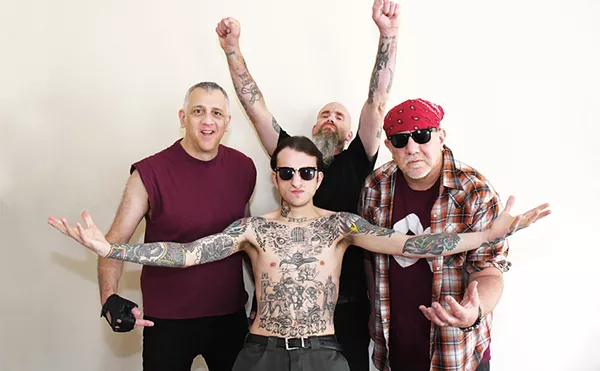There's nothing remarkable about the corner storefront at Macklind and Magnolia. Red-brick walls frame glass-brick windows, and a lit Allstate Insurance sign sits high on the northern wall, a relic of a previous tenant. Another sign, this one unlit, proclaims in modest lowercase: centro sociale. Were it not for the sign's broken-typewriter typeface and proud red stars, it could be a holdover from the days when all the signs in this neighborhood were in Italian.
Step inside, and there's no mistaking that you're in the here and now. A dozen young people sit in a circle, smoke cigarettes and argue about how to run our city's only collectively managed art and music space. They all make the decisions and nobody gets paid; this is art for art's sake, a living argument against the profit system. But the Centristas don't have time for grandiose theories when there are urgent questions to be answered: When is the darkroom going to be finished? Should we continue to allow dogs into the space? How do we run a successful hip-hop night? Can anybody get ahold of a video projector?
Welcome to the weekly meeting of the Centro Sociale collective (say "chen-tro so-chee-ah-lay"). Here, plans are made and big ideas dreamed up, with one crucial difference from so many like-minded endeavors: These things actually get done. Original artwork by several local artists fills the walls. The basement has become one of the busiest punk-rock clubs in town and is starting to host other kinds of music as well; shows are always all-ages, and no alcohol is allowed on the premises. An extensive zine library acts as a sort of countercultural museum. And then there are the weekly Monday-night meetings where everything gets hashed out. The meetings can get contentious, but there's never any doubt that everyone is here for a common purpose: to make St. Louis a better, freer and more fun place to live through art, music and activism.
"We want to get the idea to people that the mall and bars on Washington with a $10 cover aren't cultural centers, and they aren't the only way to get out of your boring life," says collective member Duane Perry. "I love St. Louis," says member Nikki Stewart, "but I find myself getting bored a lot in St. Louis. I decided instead of being bored all the time I wanted to create something like this, something that I wanted to see here." The initial impetus came from several different directions. For a couple of years, Stewart and her sister, Nina, have occasionally let bands play in the basement of the building, owned by their father, Tom. They weren't the first; until very recently, unofficial basement shows were the lifeblood of the St. Louis punk scene. Such venues as the Arsenal, the Punk Paradise, the Bordello and the Grotto were known equally for exciting shows and predictable hassles from the police.
A group of punk cohorts took a trip to Italy last January and saw that country's thriving network of anarchist community centers, at least one in every city. "All the kids hang out there, and they have shows," says member Sarah Kate Buckles, "and it's called the centro sociale."
Also, most Centristas have traveled fairly extensively in the U.S., witnessing firsthand similar efforts from New York to Berkeley. Chad Schneider, who grew up in the Twin Cities and has lived in New York, says that being involved in the Centro is one of the things keeping him in St. Louis. "It's something that really feels right," he says. "It seems like a necessary part of big-city life for people who don't want to be the same as everybody else. There needs to be an alternative."
Collective member Liz Snell agrees: "I'd say I was in desperate need of this and St. Louis was in desperate need of this," she says. As the group coalesced around the idea that a fully legal art center was possible, a series of benefit picnics in Tower Grove Park last summer raised much-needed funds. The picnic proceeds were added to the $20 a month that each member pays in dues. Cash now (barely) in hand, the group approached Tom Stewart about renting the basement and first floor of the building on Macklind. To hear group members tell it, he's been nothing but supportive.
"He's never asked us to explain anything," Snell says. "It's always been, whatever we want to do, he helps us out, no questions asked. When an inspector is there at 8 in the morning and we don't get out of bed till 8:15, Tom's always there to deal with them and tell us what we need to do."
The members unanimously consider the Centro Sociale's grand opening celebration on July 15 their most successful event yet. The all-day revel was gratifying evidence that an audience existed in St. Louis for what the Centro had to offer. One of the most eclectic musical bills in recent St. Louis history provided the soundtrack; the visuals came courtesy of several collective members. The painting and photography easily matched the quality of that shown in any art-school gallery in town, with an added punk-inspired intensity. It was an auspicious beginning and an optimistic time for the Centristas. Most heartening, it showed the Centro kids that they could reach out beyond the parochialism of the punk scene. "It was entirely varied," says collective member Matt James. "There was everything: poetry readings, bagpipers, punk bands, a hip-hop group. Films were shown, just everything."
"Every group of people that we're trying to reach out to was there," says Snell. "We had really good art from a lot of people and really good music from people mixing and people rapping to hardcore bands and girl bands." In the weeks that followed, the collective made their first foray into direct political activism with a march to protest the death sentence of Mumia Abu-Jamal. The noisy protesters commandeered a MetroLink car on the way from the U. City Loop to South Grand. This was in addition to a handful of well-attended punk shows at the space.
But much of this momentum was squandered in a months-long battle to stay open. The culturally conservative Hill neighborhood is not the most promising soil for a leftist art collective to flower in, and soon the Centro was beset by complaints from bewildered neighbors. The locals didn't see the active, focused, positive kids diligently at work; they saw the dunderheaded teen cartoon punks who flipped cigarette butts on their lawns. One angry Hill resident demanded that the Centro remove a copy of Teen Fag from the zine library (it stayed). And nobody seemed to believe that there wasn't a profit motive behind it all somewhere. As the space sat quiet and empty for weeks, waiting for this hearing or that meeting, some Centristas lost heart. Unused and unloved, the room gathered dust for two months. Some rock shows were canceled, and a Terrorist Art Organization exhibition was postponed. Morale was evaporating.
A long-awaited neighborhood association meeting in October finally turned the tide. At last the Centro kids had a chance to make their point. "We told them that we were here to bring art to a community that doesn't have a lot of art," Nikki Stewart says. "We're here for kids who wouldn't necessarily go to a gallery in the West End."
To their credit, the neighborhood association took them at their word, agreeing that such an endeavor was preferable to an empty storefront. Nikki Stewart credits her father and the neighborhood association's Susan Anderson for paving the way with City Hall. The Centro's occupancy permit hearing went off without a hitch, and suddenly the Centro Sociale was back in action. Now, says Buckles, "we love our neighbors."
But some members are skittish, remembering the feeling of having nearly lost the battle. "Sometimes I do feel uneasy," says Snell. "I feel like we've worked so hard for this, and it could be pulled out from under us at any time."
The Centristas are doing their best to put their insecurity aside and get busy with what they want to do. In addition to the steady diet of rock shows, the art-exhibit space is flourishing. Schneider credits the recent opening of the Terrorist Art Organization's Occupation show with renewing interest in the gallery. Future plans include showings of Bob Reuter's photography in January and Beth Connolly's paintings in February. Centristas may crack wise about the perpetually unfinished darkroom, but they are totally serious about getting it and other art workspaces built ASAP. The Centro writer's group starts meeting in January, and silkscreening and women's-lit workshops are in the planning stages. And a multiband girl-fest planned for February promises to be the big event of the winter.
Now the question becomes: Can they keep it going without burning out? Nobody can say, but the obvious pride that the Centro kids feel about all they've accomplished is a pretty powerful motivator. Together with such ventures as the CoLibri housing collective and the worker-owned Black Bear Bakery, they see themselves as part of a movement to change St. Louis by building nonhierarchical, alternative institutions.
"It's good that people come to St. Louis and see this collective art gallery and show space," Perry says. "I would be blown away if I went to another town and that was there. I've wanted that to be here since I was 16 years old."
The Centro Sociale, 2700 Macklind Ave., is open 6-10 p.m. Wednesday-Saturday. For more information, call 664-2839.





